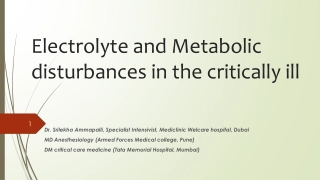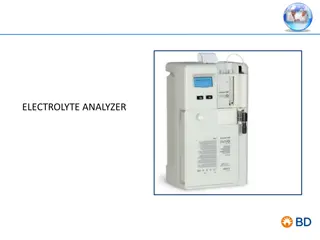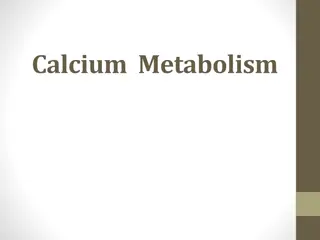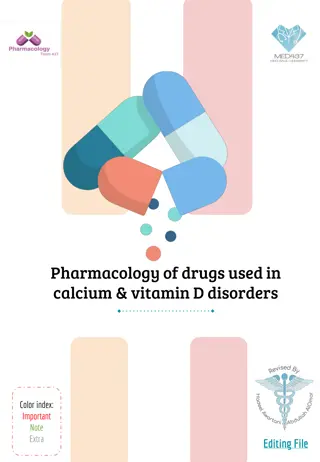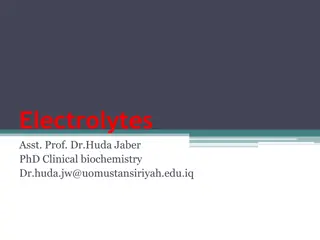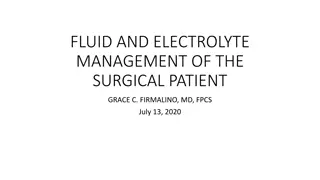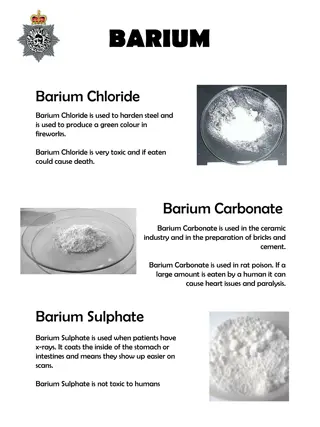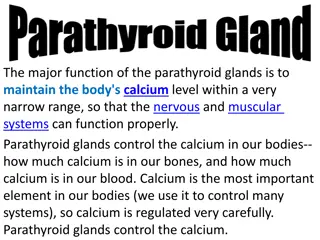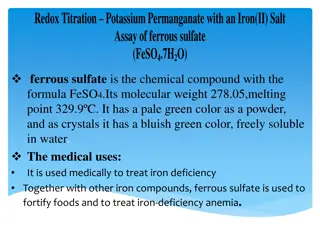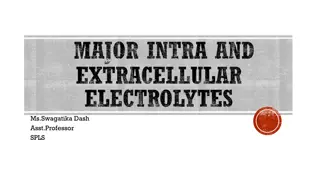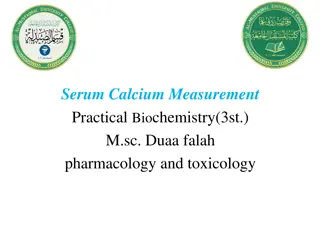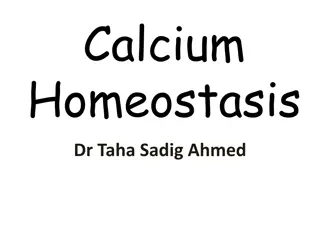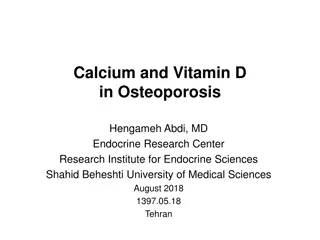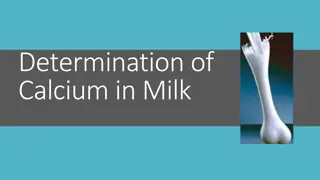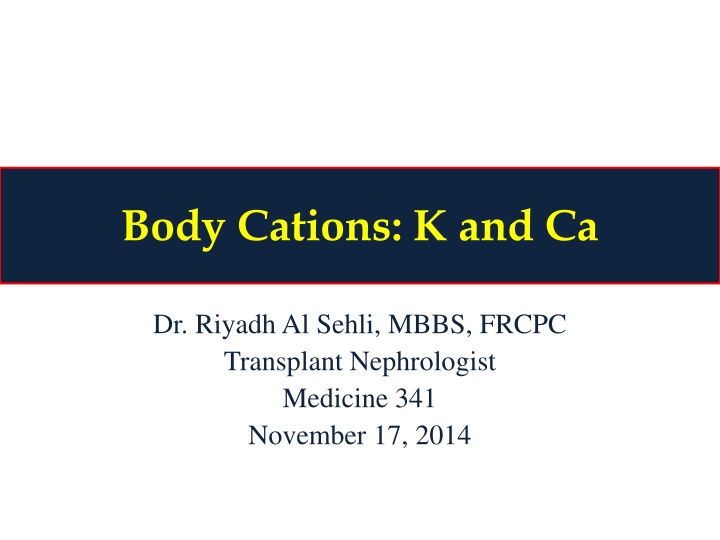
Importance of Potassium (K) in the Body
Discover the significance of potassium in the body, including its sources, daily intake, roles, and regulation. Learn about how potassium is lost, where it is located in the body, and the consequences of abnormal levels. Explore factors influencing potassium levels, such as diet, renal function, and hormonal regulation.
Download Presentation

Please find below an Image/Link to download the presentation.
The content on the website is provided AS IS for your information and personal use only. It may not be sold, licensed, or shared on other websites without obtaining consent from the author. If you encounter any issues during the download, it is possible that the publisher has removed the file from their server.
You are allowed to download the files provided on this website for personal or commercial use, subject to the condition that they are used lawfully. All files are the property of their respective owners.
The content on the website is provided AS IS for your information and personal use only. It may not be sold, licensed, or shared on other websites without obtaining consent from the author.
E N D
Presentation Transcript
Body Cations: K and Ca Dr. Riyadh Al Sehli, MBBS, FRCPC Transplant Nephrologist Medicine 341 November 17, 2014
2 important Cations Potassium [K] Calcium [Ca]
K Where does come form? How much K do we eat every day? How do we loose the K? Where does K in the body live? How does K move? Is K important? What keeps K in normal range ? What happens if K level is abnormal? What causes high K? What causes low K ?
Where does K come form? Depending on diet, the normal daily intake can vary Fruits, potatoes, beans, and grains High-fat diets usually contain low amounts of potassium Average daily intake approximately 50 to 100 mmol
How do we loose K ? Renal clearance primary mechanism Very efficient until GFR < 30 ml/min Intestinal excretion Onlyhandles 10 % of the daily K load Efficiency can be enhanced in renal failure but it is variable form one person to another
Where does K livein the body live ? Total body K is approximately 50 mmol/kg body weight K is the most abundant intracellular cation (100- 150 mmol/l) 98 % of total body K Extracellular K concentration (3.4 5.5 mmol/L) 2% of total body K
What keeps the IC K conc. high ? o Insulin , Beta agonists enhance the pump function o Beta Blockers inhibit the pump function Cvphysiology.com
What keeps EC K low? The Na/K ATPase pump Renal clearance : requires normal GFR and normal aldosterone axis Intestinal excretion
What happens when we eat K ? Oral K intake is initially absorbed in the intestine and enters portal circulation increased ECF K stimulates insulin release insulin facilitates K entry into intracellular compartment by stimulating cell membrane Na/K ATPase pump The transient rise in serum K stimulates renal and intestinal clearance of extra K
In order to Keep serum K in normal range, we need: 1. Normally functioning Na/K ATPase pump 2. intact renal response
Why is K important ? Maintains electrical gradient across cell membranes i.e. resting membrane potential essential for generation of action potential Essential for intracellular metabolism e.g protein synthesis
What happens of K level is abnormal? Skeletal muscle dysfunction: weakness and paralysis Cardiac cell irritability: arrhythmia 11/9/14 3:15 AM Hyperkalemia Figure 1. Typical electrocardiograph changes seen in patients with hyperkalemia Reprinted with permission from Slovis C, Jenkins R. ABC of clinical electrocardiography: conditions not primarily affecting the heart. BMJ 2002;324:1320. about:blank Page 1 of 2 Pediatr Nephrol (2011) 26:377 384
NA/K ATPase dysfunction Massive Cell breakdown -B blockers -Rhabdomyolysis -Digoxin - Insulin -Tumor lysis syndrome Hyperkalemia [K]>5.5 Aldosterone axis dysfunction Impaired Renal function - Adrenal deffiency -Aldosterone resistance
Can you eat too much K ? If GFR is normal, renal clearance of K has a huge adaptive capacity K intake is restricted only if: GFR is reduced existing aldosterone axis dysfunction Na/K ATPase is not efficient ( blocked by drugs, Insulin )
Rapid transcellular shift -Insulin therapy Oral intake - Malnutrition -eating disorders - Periodic paralysis Hypokalemia [K]<3.4 Renal loss -Diuretics Intestinal loss -Diarrhea -Laxative abuse -too much aldosterone
How to raise K level? Stop the loss Replace lost K with K ( PO or IV if rapid correction is urgently needed)
How to lower K level ? Reduce Cardiac muscle irritability withCa gluconate (only if EKG changes) Push K into cells: Insulin , Beta agonists Remove the K load Through the kidney: diuretics, dialysis Through the gut : Laxatives, K chelation(Ca resonium)
Ca Where does Ca come form? How much Ca do we eat every day? How do we loose the Ca? Where does Ca in the body live? How does Ca move? Is Ca important? What keeps Ca in normal range ? What happens if Ca level is abnormal? What causes high Ca? What causes low Ca ?
Where does Ca come from? Diet : 1000 1500 mg /day in average Total body Ca = 1000 g
Where does Ca live ? The vast majority of total body calcium (99%) is present in the skeleton Non-bone calcium represents 1% of total body calcium free ions (51%) protein-bound complexes (40%) ionic complexes (9%) [calcium phosphate, calcium carbonate, and calcium oxalate] Non Ionized
Why Ca is important ? Bone Ca skeletal strength dynamic store Non-Bone Ca extra- and intracellular signaling nerve impulse transmission muscle contraction
What keeps Ca in balance ? Total intake Rate of intestinal absorption Intestinal excretion Renal reabsorption Renal excretion Bone turnover All these parameters are controlled by 1- PTH 2- Active Vitamin D 3-Serum Ionized Ca level
PTH is a hyper-calcemic hormone Release of Ca form bones (bone resorption) Renal absorption of Ca Activates Vitamin D in the kidney
Active Vitamin D is also hyper-calcemic Intestinal absorption of Ca Bone resorption
Hormonal mechanisms maintain narrow physiologic range of 10%. Clin J Am Soc Nephrol 5: S23 S30, 2010
What can go wrong ? Oral intake Intestinal absorption Renal reabsorption Renal excretion Intestinal excretion Bone turnover PTH Active Vitamin D
Intestinal absorprtion Renal reabsorprtion - Increased intake - Hyperparathyroidism - Increased Vit D -Thiazide diuretics Hypercalcemia PTH Bone resorption -Primary hyperparathyroidism -Multiple Endocrine Neoplasia Vit D -Osteoclastic bone metastasis -Immobilization -Intoxication
Renal reabsorprtion - hypoparathyroidism Intestinal absorprtion - Decreased intake -malabsorption -Loop diuretics -Small bowel reseciton -Tubular defects - Vit D defficiency Hypocalcemia PTH - hypoparathyroidism Vit D - Renal failure Bone remodling -Osteoblastic bone metastasis -Hungry bone syndrome -
Parasthesia Spasm Chvostek s sign Trousseau s sign Seizure Dementia Extrapyramidal Papillidema Cataract Neuropsychiatric Neuromascular Cardiovascular Autonomic Prolonged QT interval Heart failure Hypotension Biliary colic Bronchospasm Diaphoresis

